The color of a mole directly depends on the processes of skin pigmentation. In this regard, sometimes nevi become more saturated in color, and this is normal. But the appearance of a black mole may indicate health problems and require immediate medical intervention. There is always a risk of it degenerating into melanoma. Experts insist on regular examination of the body for new black moles.
Typically, moles, including black ones, are present on the human body from birth or appear before the child reaches 16 years of age. At this age, the appearance of nevi of such a dark color is not considered a pathology. But if the mole formed at a later period and is increasing, then you may need to see a doctor. Read more about the formation of nevi in the article about the reasons for the appearance of moles on the body.
What does blackening of a nevus mean?
The appearance of black moles is associated with the accumulation of melanin. It is he who is responsible for the saturation of the nevus pigment. With a large amount of melanin, you may notice that a mole, which until recently was much lighter, has turned black. But this does not mean that she is now a danger.
Normally, the size of a nevus does not exceed 6 mm and should not increase over time. At the same time, its surface remains smooth, without growths and roughness. The form also matters. Only those formations that have uneven outlines are considered dangerous.
It is worth paying attention to moles that have changed their color to a darker one. If the nevus suddenly darkens, this is one of the signs of cancer. Symptoms of a malignant neoplasm are also considered:
- change in size - the mole began to sharply increase or decrease;
- bleeding from a nevus without damaging it;
- hair loss;
- the mole is inflamed and hurts;
- the appearance of a rim around the nevus, gray or red dots;
- itching or burning sensations;
- the skin around the nevus dries out.
If there is at least one of the listed signs, then this indicates a malignant process. A dermatologist will help you find out why a mole turns black.
Why do moles darken?
The main reasons that a mole has darkened are:
1. Exposure to sunlight. Ultraviolet light promotes the accumulation of melanin pigment. Therefore, after prolonged exposure to the sun, many people notice that the mole has turned completely or partially black. Darker spots may appear on it. It is necessary to protect nevi from the sun to avoid their degeneration. Experts also recommend avoiding solariums for those who have a lot of them.
2. Often the reason that the nevus has darkened lies in changes in hormone levels. This is noted by women during pregnancy or menopause. Adolescence is no exception.
3. Mechanical impact. A mole may turn black if it is damaged. This often occurs upon contact with clothing or household items. Hanging moles are more susceptible to various types of damage. They are a regular nevus, but on a stalk.
If you have hanging moles, you need to be extremely careful. They are the ones that can darken and become inflamed, for example, when rubbing with clothing. If a hanging mole has turned black, then its blood supply may have been disrupted. One of the reasons is injuries. Gradually, the mole will turn black, may dry out and even fall off.
When should you see a doctor?
Doctors do not advise removing nevi without a good reason, even if they have changed color. Hanging moles are subject to excision if they are located in an unfavorable location and permanent damage occurs. The appearance of even black moles on the body is normal. Especially if a person has to constantly be under the sun's rays. But if the nevus, which is located under clothing, has darkened, then you need to have it checked by a specialist.
It is also not recommended to get rid of black formations with home remedies, such as acetic acid lotions. Traditional recipes will allow you to remove only the upper part of the nevus, which is located on the surface of the skin. Its base will remain in the deeper layers of the epidermis and can transform into a dangerous form - melanoma.
If a malignant tumor is suspected, tests are done. If their results are positive, the doctor will remove the nevus. After surgery, the patient may be prescribed a course of chemotherapy or radiation therapy. If the tests do not confirm the presence of pathology, but the person still wants to remove the blackened nevus, then more humane methods of intervention are used, such as a radioknife, laser or liquid nitrogen.
You should consult a doctor if:
- it was noticed that the black mole was covered with a crust;
- itches;
- enlarged or painful;
- dried out and began to peel off.
It is these signs that indicate a malignant process.
The crust on the nevus has a different color:
1. A brown tint indicates that the mole has been damaged.
2. The crust often turns black in the place where the nevus was before it was removed. This is a normal phenomenon and means that the wound is healing.
3. A dark crust appears after visiting a solarium or sauna.
Regardless of the color of the crust, you should consult your doctor to determine whether the nevus is dangerous. If the nevus turns black, this is a cause for concern. But then it may fall off. This is especially true for hanging moles. Many people do not go to the doctor if they fall off. But this does not mean that the danger has passed. Even if the mole falls off, the malignant process continues.
Since symptoms of a tumor often do not appear for a long time, it is best to submit a fallen mole for histology. With this study it will be possible to determine whether there are altered cells in it.
Methods for removing nevi
If the mole behaves suspiciously, and the doctor has confirmed that it needs to be removed, then the nevus is excised using one of the recommended methods:
1. Laser destruction. The method involves the destruction of pigmented cells of a black mole. The specialist acts on them with a directed laser beam. It provokes thermal evaporation of the tissue of the skin defect. This procedure is absolutely safe and painless. The laser does not leave scars on the patient's body.
2. Electrocoagulation. The technique involves the use of high-frequency electric current. It destroys the cells of the pigmented epidermis. It is often used when it is necessary not only to get rid of a nevus, but also to obtain tissue for research.
3. Cryodestruction. The method allows you to quickly get rid of black nevi by exposing them to cooled liquid nitrogen. The cells are destroyed and the formation dies.
4. Radio wave surgery is a low-traumatic procedure that allows you to remove black nevi on the face and body. The specialist influences the formation with high-frequency radio waves. The postoperative wound heals very quickly, leaving no scar.
5. Surgical intervention. The operation is performed only if a malignant neoplasm is detected or a large mole whose roots are located very deep needs to be removed. The procedure is performed under anesthesia. Then stitches are placed, which are removed after a few days. This method of removing nevi leads to the formation of scars, sometimes very noticeable. Surgery increases the risk of pain, bleeding and infection of the wound. It is highly undesirable to use this method to remove moles on the face unless there are strict indications for this.
Any of the methods is suitable for removing a hanging mole. If the mole is blackened, inflamed, hurts, or has been damaged, then excision must be performed using any of the listed methods, except surgically. The latter method is advisable for removing nevi that have degenerated into a malignant formation. You can find out about the presence of pathological cells by conducting a dermoscopic examination. The excised tissues are sent for histology. Based on the results of these tests, the doctor will decide whether to get rid of the mole.
Almost all of us have nevi (as moles are called in medicine). We get used to these dark spots on the body, which give a person a certain peculiarity, charm. Usually, once a nevus appears, it stays with us for life. But what does the fact that the mole has darkened indicate? Should I see a doctor? What are the warning signs of a process when a harmless mole degenerates into malignant melanoma?
What is a nevus?
A mole is a consequence of the excessive work of melanocytes (cells that produce melanin), the accumulation of the pigment they produce. The more melanin spots in the cells, the darker the nevus will be. A person can have these marks from birth. Sometimes they appear throughout life - mostly before the age of 16.
The mole has darkened. Don't be scared right away. This is a normal process if it is associated with the development of a formation - a newly appeared mole. It is “born” as a light spot, which darkens over time, approaching its permanent shade. However, we note that the period of development is always gradual and consistent.
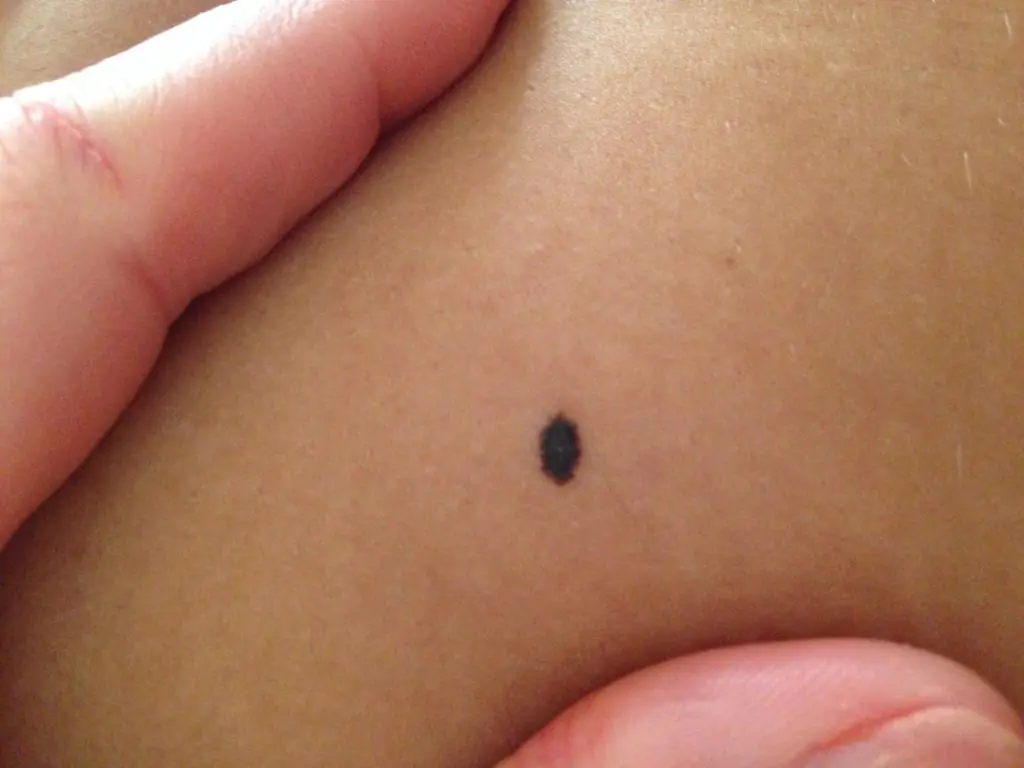
Signs of a safe mole
The nevi themselves are safe for the life and health of the owner of the mark. Signs of a normal mole:
- No more than 6 mm in diameter.
- Static in size - does not grow.
- Has smooth (not sharp) edges.
- Smooth surface.
- There are no roughness or growths.
- Static in color.
If black dots appear inside the nevus, which increase in size and go beyond its boundaries, then this may be one of the signs of melanoma. What is this? A malignant formation of the skin, which can lead to serious consequences for human health, like any cancerous tumor. The transformation of a harmless nevus into melanoma is called malignancy. A number of factors can provoke this.
Thus, if a mole has darkened, then this is a reason to pay attention to the nevus. But this will not be a defining sign of the development of melanoma.
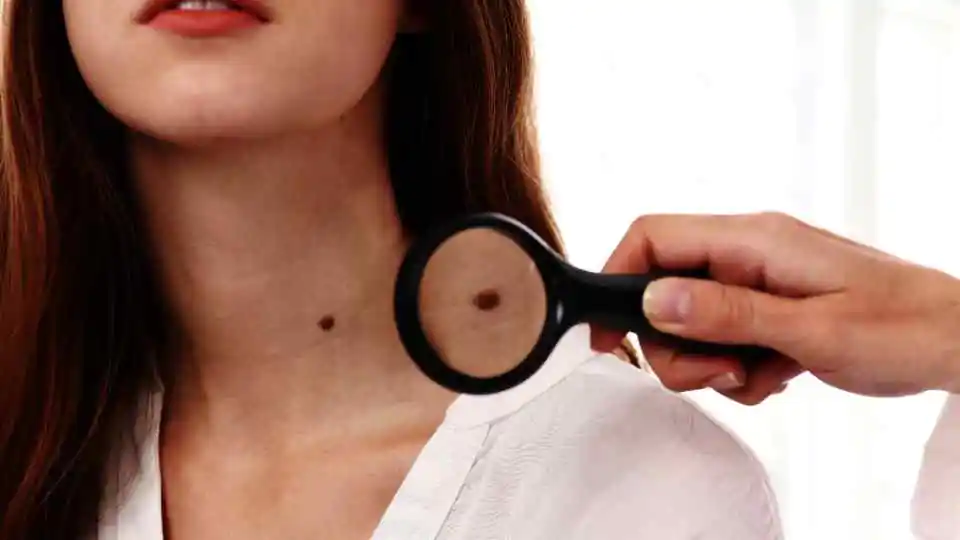
Why did the mole darken?
Changes in nevi lie in the action of certain factors on them. Can a mole darken? Yes, and it’s all about the reasons that affect the activity of melanocytes (and, accordingly, the amount of pigment they produce). This is the following:
- UV rays. Ultraviolet light most contributes to the accumulation of melanin in cells. That's why we get a chocolate tan under the rays of the sun and solarium lamps. If you periodically spend a long time in the sun, you may notice that the mole has darkened along with the skin (sometimes the nevus becomes almost black, black spots appear on it). Experts advise protecting marks from direct exposure to UV rays - using protective equipment, covering yourself with clothes, and not sunbathing in the sun from 11 a.m. to 4 p.m. If you have a lot of moles on your body, then it is better to avoid going to the solarium.
- Changes in hormonal levels. This condition also affects the production of melanin. Therefore, nevi can darken during adolescence, pregnancy and menopause in women. The darkening of nevi is one of the external signals that the body is being rebuilt and there is an imbalance in its systems.
- Damage. A mole may well change its color due to mechanical impact on it or injury. The cause could even be constant friction against clothing.

What is a hanging nevus?
Let’s look separately at why the hanging mole has darkened. This is an ordinary harmless nevus, but located not in the thickness of the skin, but on the so-called stalk - attached to the epithelium with a small thin piece of tissue. A number of experts note that such moles are less likely than others to degenerate into dangerous melanoma. They are distinguished by their flesh color, somewhat rough surface and small size.
These formations cause discomfort to their owner because they are more susceptible to mechanical damage from clothing, hygiene items, jewelry, etc. than other nevi. Basically, they are located in “traumatic” locations - in the armpits, on the neck, in the intimate area.
The hanging nevus has darkened - what's the matter?
If a hanging mole has darkened, then the reasons for the change lie in the following:
- Again, excessive exposure of the owner to UV rays.
- Restructuring of hormonal levels.
- Mechanical injury. The most common reason. As a result of injury, a hanging mole can not only darken, but also become inflamed, begin to dry out, and even fall off.
- Another reason for the blackening of such a nevus is a violation of the blood supply to its tissues.
How dangerous is damage to a hanging nevus? Even if the pedunculated area has darkened and torn off, the base of the mole still remains deep in the layers of the skin. Damage can cause the proliferation of nevus cells in the thickness of the epithelium. This process can only be stopped surgically - by removing them.
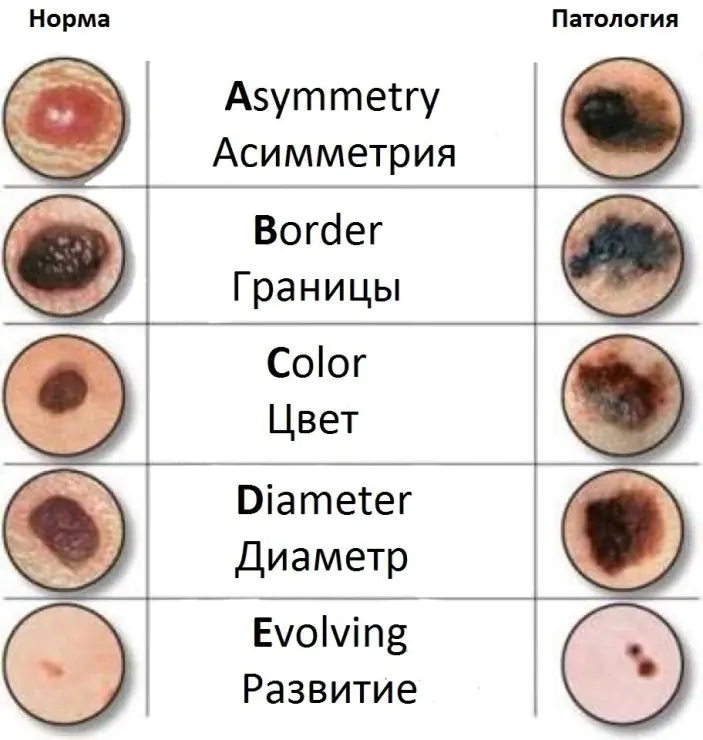
Dangerous symptoms of degeneration into melanoma
First of all, we note that blackening of the nevus is in itself an alarming symptom! Yes, sometimes the reason can be banal and harmless - friction on clothes, frequent exposure to the scorching rays of the sun. But this is still a sufficient reason to contact a specialist - a dermatologist or oncologist. This way you can stop the development of melanoma in time. Or reassure yourself that everything is fine with your health.
The mole has enlarged and darkened. What could this mean? If the blackening of the nevus is accompanied by other unclear symptoms, this is a reason to urgently consult a doctor! Let's present a list of the most common signs of malignancy:
- A sharp increase in size of the formation, a change in its shape and shade.
- Liquid, blood, and mucus are often released from the nevus.
- Hairs have appeared on the mole (if they did not grow there before).
- The nevus was surrounded by a white halo of discolored skin.
- Red, black, or other different colored spots appear on the mole.
- The surface of the nevus became rough, covered with roughness and cracks.
- The skin both at the site of the mark itself and around it has become denser.
- You feel unpleasant sensations in the location of the nevus - itching, pain.
If a mole has darkened or become convex, do not hesitate, consult an experienced doctor as soon as possible! Even one of the above symptoms is a sufficient reason for a visit.
What to do if a mole has darkened?
Let us remind you once again that the first thing you need to do is contact a medical clinic, a qualified specialist. But darkening of a mole in itself is not a sufficient reason for making a diagnosis.
The patient will be asked to undergo several diagnostic procedures. First, a visual inspection by a specialist. Then - testing (skiascopy, dermatoscopy). If the clinical picture is controversial, then an additional biopsy is prescribed.
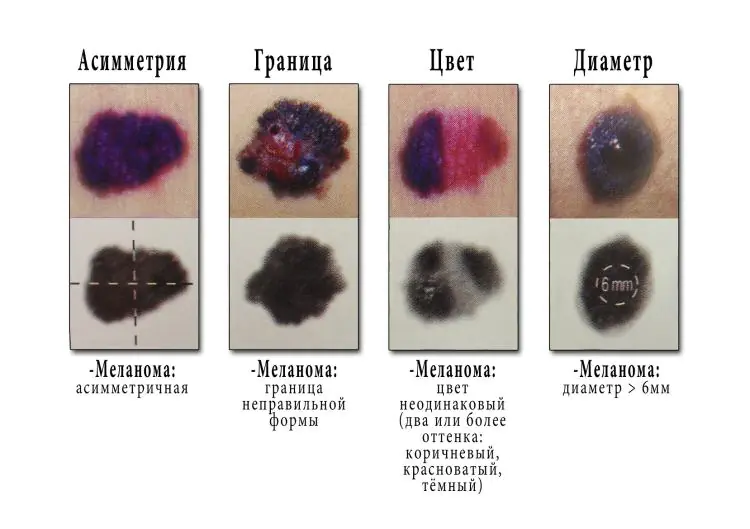
What is the treatment?
Subsequent therapy is based on the diagnosis revealed by the results of examinations:
- Degeneration of nevus into melanoma. In this case, a traditional operation is performed under local anesthesia to remove the formation. After this, the tumor tissues are sent for histological analysis to assess their malignancy. The disadvantage of this method is that it does not prevent recurrence of such cases. But still, today this is the surest way to get rid of malignant tumors.
- Nevus does not pose a health hazard. The patient will be offered recommendations to prevent moles from degenerating into melanomas. A harmless darkened nevus can be removed using a number of hardware methods - cryodestruction (exposure to liquid nitrogen), radioknife (removal using high-frequency electromagnetic waves), electrodestruction (removal of a nevus using electric current), laser therapy methods.
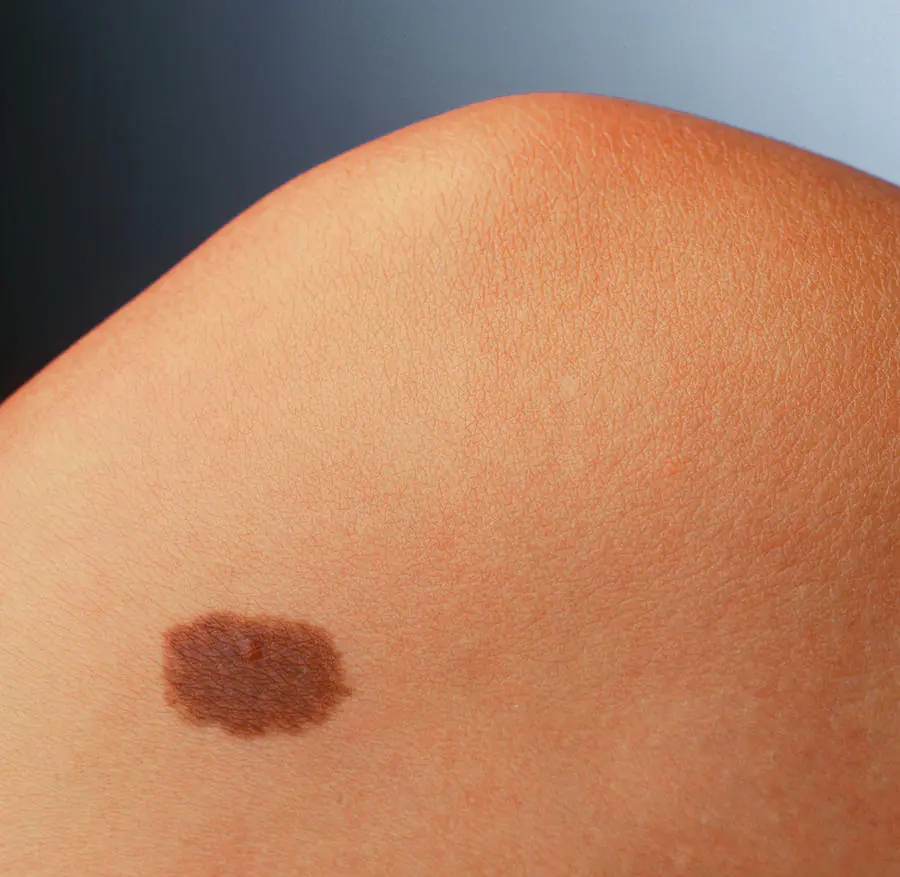
This cannot be done!
You have noticed that one or more nevi on your body have darkened. Now we will present examples of what can aggravate your condition and cause serious consequences:
- Self-diagnosis and self-medication. The cause of darkening of a mole can only be determined by a qualified doctor. He makes recommendations for the patient’s further actions.
- Self-removal of a mole. This is especially true for pedunculated nevi. The consequences of such actions can be the most dire - from infection to accelerated development of melanoma.
- The use of traditional medicine. Even after consulting a doctor, many people still deviate from the prescribed treatment. They are attracted to folk remedies that are rumored to bring quick and painless positive results. However, remember that any chemical and mechanical effects on the nevus without its further complete removal only accelerate the rate at which this harmless formation turns into melanoma.
- Following controversial advice. On the Internet you can find recommendations of a similar plan: cover darkened moles before visiting the beach and solarium - they say, this will protect them from the harmful effects of UV rays. But in this way you also create a negative greenhouse effect. It is safer for life and health to follow the recommendations of your doctor.
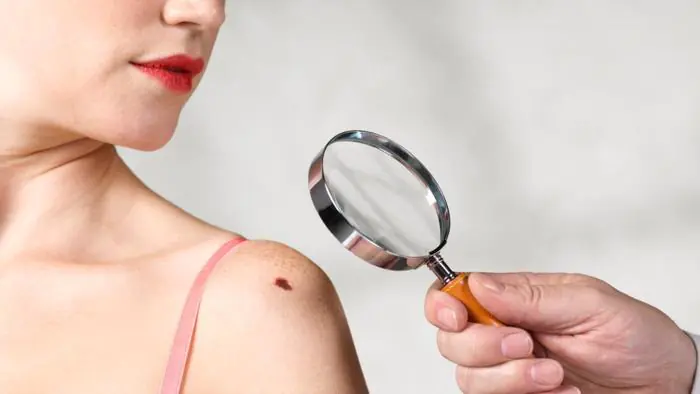
Now we know that darkening of a mole can be the result of both hormonal changes, too intense tanning, mechanical damage, and dangerous malignant melanoma. Therefore, your only course of action here is to contact a specialist as soon as possible.
A dark-colored nevus in medicine is considered a benign neoplasm when it appears on the human body before reaching the age of sixteen. If a light mole suddenly turns black, this is a reason to make an appointment with a dermatologist and undergo a full examination to identify signs of malignancy.
Symptoms of malignant moles
Any moles change over time, and a typical nevus has a uniform color, clear boundaries that separate the “body of the formation” from the surrounding skin, and the size does not exceed 2 cm. Most people have approximately 10-45 such moles on their body. They continue to appear until the age of forty, some disappear with age. Atypical nevi differ from ordinary nevi in their appearance.
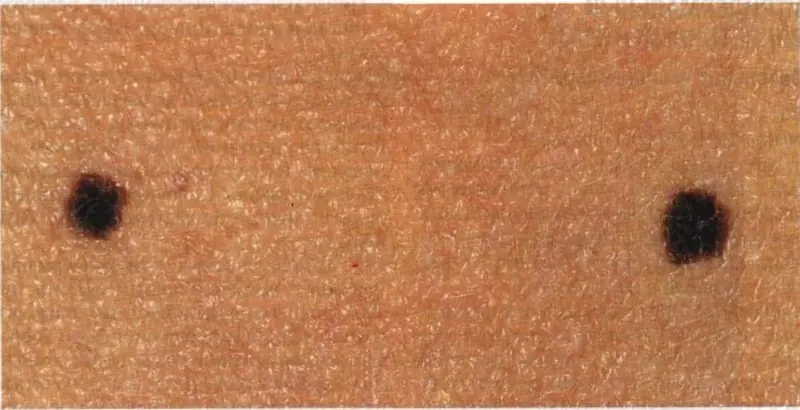
There are several signs that may indicate the beginning of the transformation of a mole into an oncological formation:
- Presence of asymmetry. If you visually draw a line in the center, for a typical mole both halves located on both sides will be exactly the same in shape. Cancer cells always divide unevenly, so lack of symmetry is the first sign of malignancy.
- Shape of borders. The edges of a malignant formation are always uneven, torn, and similar to teeth.
- Dark color. Discoloration is the first sign of malignancy. If a mole suddenly darkens, if dark inclusions appear in its structure, making the surface uneven, this is a reason for concern.
- Increase in diameter. Melanoma increases in size very quickly; it grows, as they say, “before our eyes.”
Benign nevi continue to be the same over time, malignant ones change, taking into account all the signs listed above.
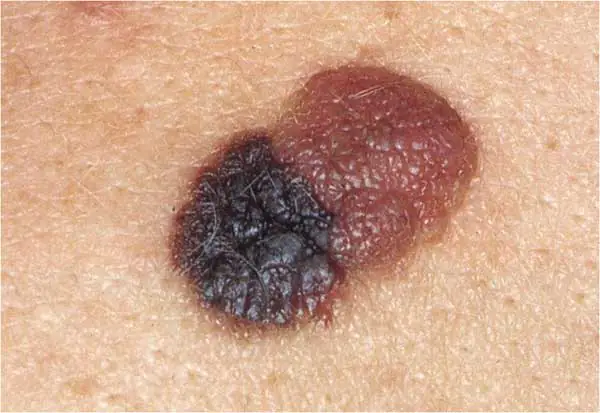
Causes of darkening of the nevus
Various factors can provoke malignancy processes.
- sunburn;
- daily excessive exposure of the skin to ultraviolet radiation;
- permanent injury to the nevus;
- hormonal imbalances.
In addition, it has been noticed that most often moles that grow in a person with snow-white skin, blond hair and blue eyes, or in people with a large number of freckles on the body, degenerate into malignant formations. The presence of a large number of typical nevi (more than a hundred pieces) increases the risk of malignancy; the hereditary factor also plays an important role (presence of a history of skin cancer in first-degree relatives).
What to look for
Everyone who is at risk needs to constantly monitor moles on the body, keep a diary and describe the condition of each nevus in it, or better yet, take photographs and compare the development of the formation from the pictures. A melanoma-dangerous mole turns black in a short period of time, becomes crusty, the skin around it becomes inflamed, a burning sensation or mild itching appears, the boundaries blur, and take on an irregular shape. Darkened areas of skin appear around the primary mole. If such changes are detected, you should immediately contact a dermatologist.
Melanoma-dangerous moles (pink hanging nevi) change their color in most cases due to mechanical damage. If the formation is torn, it may turn black (cells deprived of nutrition die). This is not a sign of degeneration, but you still need to see a doctor: the roots of the mole remain inside the skin, nevus cells spread throughout the body, so new hanging moles may appear on the body. If you see a doctor and remove the remaining base, the skin will remain clear.
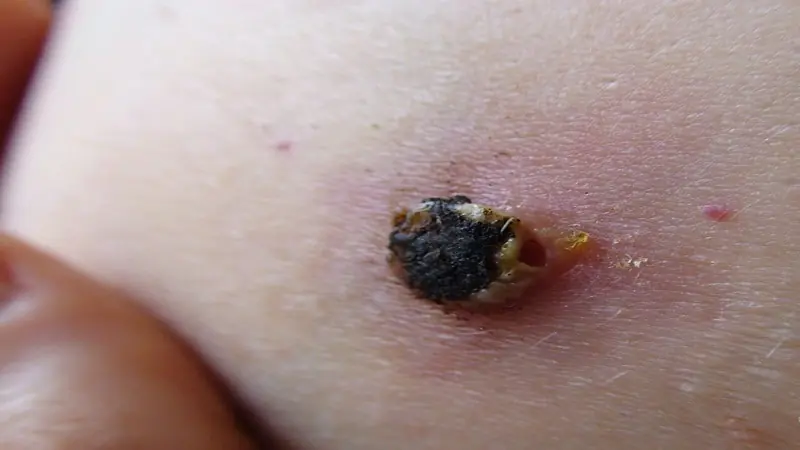
Ways to remove moles
A dangerous diagnosis can be confirmed by undergoing a full examination. At the first stage, the doctor, armed with a dermatoscope, carefully examines the suspicious element. If the examination reveals atypical signs, the specialist invites his patient to do a biopsy and undergo histological tests. Only after this treatment tactics are developed.
What to do if malignancy is confirmed? The only way to save your life is to remove the atypical nevus along with the tissues adjacent to it. For these purposes, only standard surgery can be used. Neither cryodestruction, nor electrocoagulation, nor laser therapy allows, after the procedure, to obtain biological material that may be needed for laboratory examination of the tumor surface. Without it, it is difficult to understand the level of prevalence of the oncological process and make a prognosis.
Cancerous moles are removed taking into account the following recommendations:
- During the operation, the surgeon must excise the nevus along with a centimeter-long section of healthy tissue located on the sides of the periphery, and also remove the deep layer of skin down to the fatty tissue.
- If melanoma is up to two millimeters thick, the “margin” increases to two centimeters.
- If a cancerous mole is more than two millimeters thick, it is excised, including healthy skin up to three centimeters wide.
- When laboratory tests show the presence of a metastatic phase, the lymph nodes closest to the nevus are also removed during surgery. In later stages, chemotherapy is required after surgery.
The thickness of the tumor and the number of skin layers affected by the pathology are the main criteria that help make predictions about the level of survival. If the thickness of melanoma does not exceed one millimeter, oncology has high rates of cure. The higher this indicator, the worse the forecasts.
Skin care after mole removal
After the operation, the wound is sutured, treated with an antiseptic, and an anti-inflammatory and wound-healing ointment and bandage are applied on top. The wound treatment procedure must be repeated in the same sequence every day. To prevent the development of infection, the patient must take systemic antibiotics.
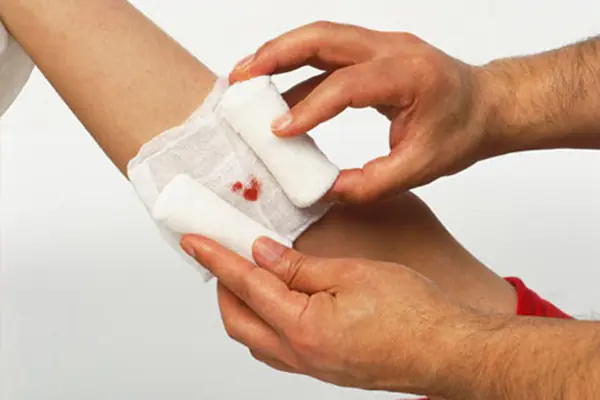
After six days, the sutures are removed; complete healing of the skin takes up to one and a half months. During this time, you should try to avoid direct sunlight. You cannot visit baths and saunas, or swim in open water.



